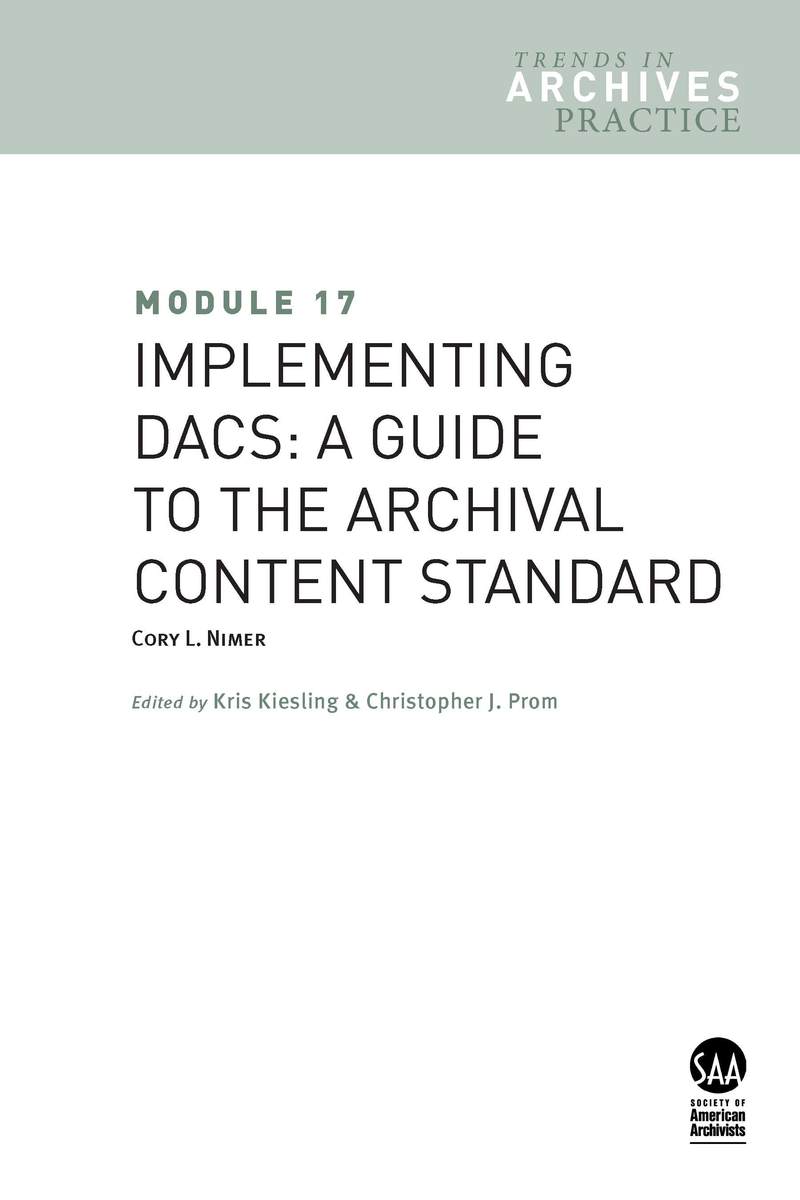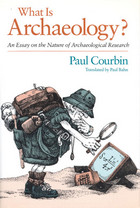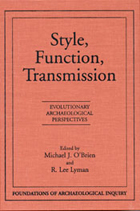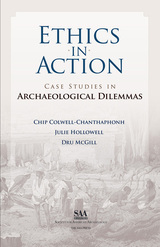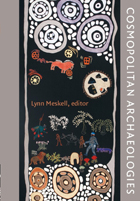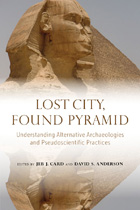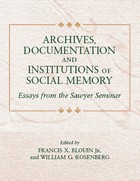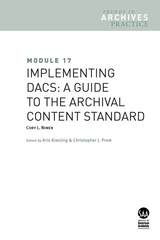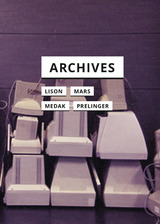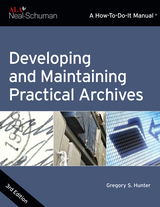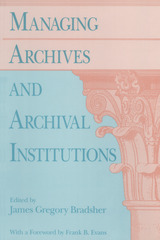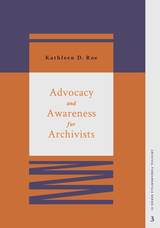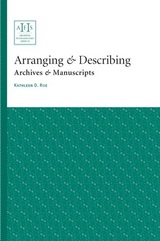Module 17: Implementing DACS: A Guide to the Archival Content Standard
by Cory Nimer
edited by Christopher Prom and Kris Kiesling
edited by Christopher Prom and Kris Kiesling
Society of American Archivists, 2017
eISBN: 978-1-931666-03-9 (ePub) | eISBN: 978-1-931666-02-2 (PDF)
Library of Congress Classification CD935.J46 2003
Dewey Decimal Classification 025.171
eISBN: 978-1-931666-03-9 (ePub) | eISBN: 978-1-931666-02-2 (PDF)
Library of Congress Classification CD935.J46 2003
Dewey Decimal Classification 025.171
ABOUT THIS BOOK | AUTHOR BIOGRAPHY | TOC | REQUEST ACCESSIBLE FILE
ABOUT THIS BOOK
Leads archivists through the provisions of Describing Archives: A Content Standard (DACS) with the aim of assisting institutions in choosing between available options and creating documentation for local application. Includes extended examples of recording DACS content in EAD3, EAC-CPF, and MARC formats.
AUTHOR BIOGRAPHY
Cory L. Nimer is the university archivist at Brigham Young University, where he previously served as a manuscript cataloger, metadata specialist, and technical services archivist. He has served the Society of American Archivists on a number of standards-related bodies, including the Standards Committee, the Technical Subcommittee on Descriptive Standards, and the Technical Subcommittee on Encoded Archival Standards, and as the SAA Representative to the American Library Association's Committee on Cataloging: Description and Access (CC:DA) and the MARC Advisory Committee. Nimer holds an MA in history from Sonoma State University and an MLIS from San José State University.
TABLE OF CONTENTS
- Preface • 12
Introduction • 13
Establishing Standards • 13
Background on the Standard • 14
Archival Description and the Cultural Heritage Community • 17
Administrative Considerations • 18
A Note on Organization • 20
Describing Archival Materials • 22
Levels of Description • 24
Identity Statement Area Elements • 25
Reference Code Element (DACS 2.1; Required) • 25
Name and Location of Repository Element (DACS 2.2; Required) • 27
Title Element (DACS 2.3; Required) • 29
Date Element (DACS 2.4; Required) • 32
Extent Element (DACS 2.5; Required) • 35
Administrative/Biographical History Element (DACS 2.7; Optimum) • 39
Content and Structure Elements • 42
Scope and Content Element (DACS 3.1; Required) • 42
System of Arrangement Element (DACS 3.2; Added value) • 44
Conditions of Access and Use Elements • 46
Conditions Governing Access Element (DACS 4.1; Required) • 46
Physical Access Element (DACS 4.2; Added value) • 48
Technical Access Element (DACS 4.3; Added value) • 50
Conditions Governing Reproduction and Use Element (DACS 4.4;
Added value) • 51
Language and Scripts of the Material Element (DACS 4.5; Required) • 53
Acquisition and Appraisal Elements • 54
Custodial History Element (DACS 5.1; Added value) • 54
Immediate Source of Acquisition Element (DACS 5.2; Added value) • 56
Appraisal, Destruction, and Scheduling Information Element (DACS 5.3;
Added value) • 57
Accruals Element (DACS 5.4; Added value) • 59
Notes Area Element • 60
Note Element (DACS 7.1; Added value) • 60
Description Control Area Element • 62
Description Control Element (DACS 8.1; Added value) • 62
Describing Archival Creators • 65
Levels of Description • 66
Identity Area Elements • 67
Authorized Form of the Name Element (DACS 10.1; Required) • 67
Type of Entity Element (DACS 10.2; Required) • 68
Variant Forms of Names Element (DACS 10.3; Added value) • 70
Identifiers for Corporate Bodies Element (DACS 10.4; Added value) • 73
Description Area Elements • 74
Dates of Existence Element (DACS 11.1; Required) • 74
Historical Summary Element (DACS 11.2; Added value) • 76
Places Element (DACS 11.3; Added value) • 78
Legal Status Element (DACS 11.4; Added value) • 81
Functions, Occupations, and Activities Element (DACS 11.5;
Added value) • 82
Mandates/Source of Authority Element (DACS 11.6; Added value) • 84
Internal Structure/Genealogy Element (DACS 11.7; Added value) • 85
Control Area Elements • 87
Repository Code Element (DACS 13.1; Added value) • 87
Authority Record Identifier Element (DACS 13.2; Required) • 89
Rules or Conventions Element (DACS 13.3; Added value) • 90
Status Element (DACS 13.4; Added value) • 91
Level of Detail Element (DACS 13.5; Added value) • 92
Date(s) of Authority Record Creation and Revision Element (DACS 13.6; Added value) • 93
Languages or Scripts Element (DACS 13.7; Added value) • 95
Sources Element (DACS 13.8; Added value) • 96
Maintenance Information Element (DACS 13.9; Added value) • 98
Describing Relationships • 99
Levels of Description • 100
Relationships Between Materials and Creators • 100
Name of Creator(s) Element (DACS 2.6; Required, if known) • 100
Identifiers and Titles of Related Resources Element (DACS 14.1;
Added value) • 102
Types of Related Resources Element (DACS 14.2; Added value) • 104
Nature of Relationship to Related Resources Element (DACS 14.3;
Added value) • 105
8 PUTTING DESCRIPTIVE STANDARDS TO WORK
Dates of Related Resources and/or Relationships Element (DACS 14.4;
Added value) • 106
Relationships Between Materials • 107
Existence and Location of Originals Element (DACS 6.1; Added value) • 107
Existence and Location of Copies Element (DACS 6.2; Added value) • 110
Related Archival Materials Element (DACS 6.3; Added value) • 112
Publication Note Element (DACS 6.4; Added value) • 114
Finding Aids Element (DACS 4.6; Added value) • 116
Relationships Between Creators • 118
Names/Identifiers of Related Corporate Bodies, Persons, or Families
Element (DACS 12.1; Added value) • 118
Type of Related Entity Element (DACS 12.2; Added value) • 120
Nature of Relationship Element (DACS 12.3; Added value) • 121
Dates of the Relationship Element (DACS 12.4; Added value) • 123
Providing Additional Access • 124
Subject Access • 124
Genre/Forms • 127
Occupational Access • 130
Functional Access • 132
Future Trends • 134
Appendices
Appendix A: Further Readings • 137
Appendix B: Acronyms • 154
Sidebars
Case Studies on Implementation Documentation • 21
Case Studies on Description Implementation Planning • 23
Case Studies on Planning for Archival Authorities • 66
REQUEST ACCESSIBLE FILE
If you are a student who cannot use this book in printed form, BiblioVault may be able to supply you with an electronic file for alternative access.
Please have the accessibility coordinator at your school fill out this form.
It can take 2-3 weeks for requests to be filled.
See other books on: Archives | Great Britain | Guide | Kiesling, Kris | Prom, Christopher
See other titles from Society of American Archivists
Nearby on shelf for Diplomatics. Archives. Seals / Archives:
9780226116563
9781945246043
